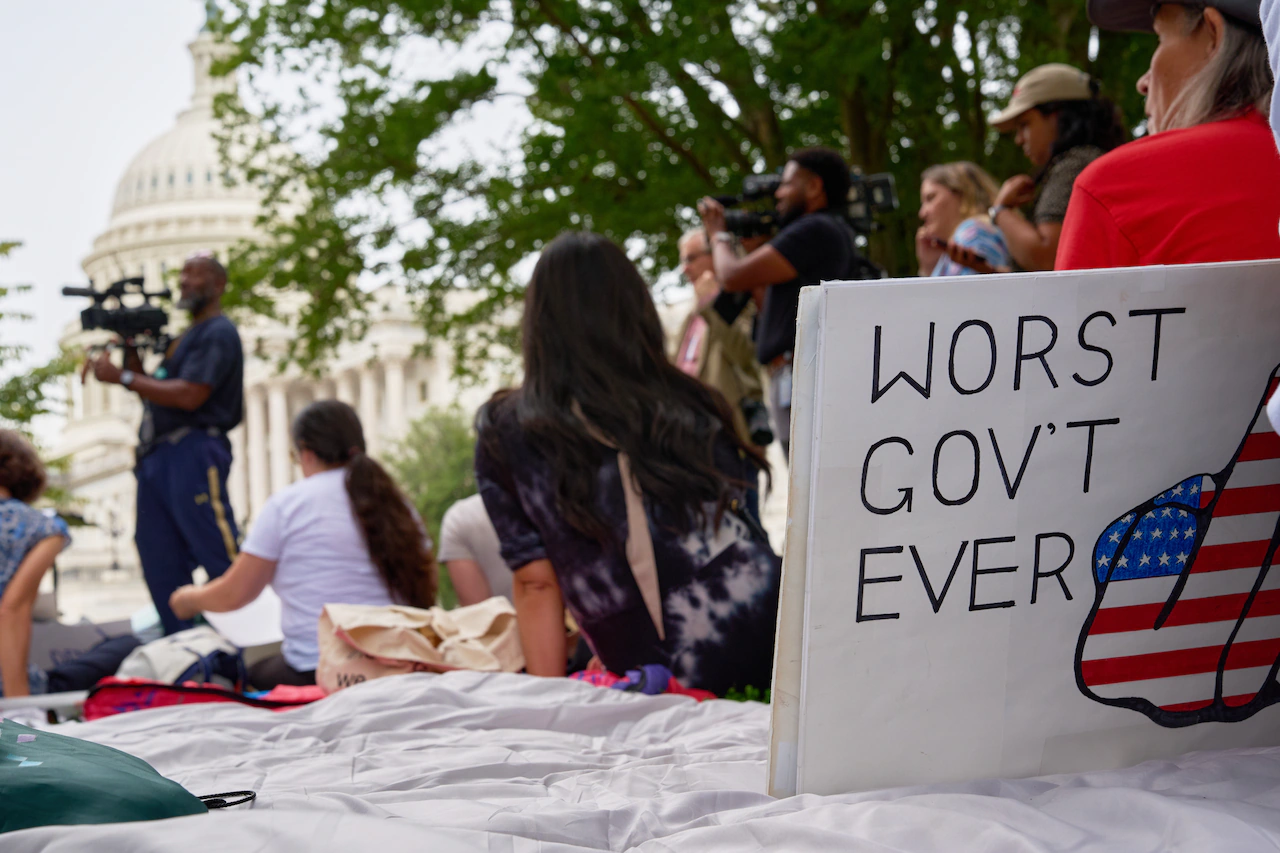
WASHINGTON — The federal government shut down just after 12 a.m. Wednesday, Oct. 1, as lawmakers failed to reach a funding agreement, with Ohio’s Republican and Democratic congressional delegation blaming the other party for the impasse that will disrupt services for millions of Americans.
In a shutdown, hundreds of thousands of federal employees are furloughed or work without pay, government offices close, national parks may become inaccessible, and many federal services halt. Mail delivery and Social Security payments continue, but passport processing stops and new benefit claims face delays.
Ohio’s two Republican U.S. Senators blamed Democrats in the Senate for refusing to support a temporary funding measure that passed the U.S. House of Representatives along party lines in September.
“The Republicans made a very simple offer to Democrats,” Sen. Bernie Moreno of Westlake told Fox News on Saturday. “We’re going to keep the Biden level spending at level amount. We’re not going to change it to give us six more weeks to come up with a budget that has our priorities.”
Moreno suggested Republicans might welcome a prolonged shutdown as an opportunity for structural changes to the federal government. “Once that structural change is done, we will have a dramatically smaller federal government,” he said.
Sen. Jon Husted of the Columbus area issued a statement shortly after midnight that said the Senate needs Republicans and Democrats working together to keep the government open
“Republicans aren’t playing games,” Husted’s statement continued. “We offered a clean plan to keep the government running with no changes in policy or funding—exactly the same budget Democrats supported 13 times under President Biden. This time, they rejected it.
“I’m working with my colleagues to reopen the government as quickly as possible … Ohioans get up and go to work every day, and they get the job done. Congress should do the same. We should get our job done and reopen the government.”
Ohio’s Democratic representatives fired back, noting that Republicans control the White House and both chambers of Congress.
“I’m here in Washington along with my Democratic colleagues, because government funding runs out in two days,” U.S. Rep. Shontel Brown, a Warrensville Heights Democrat, said in a Monday social media video. “And where are the Republicans? Well, I can’t tell you where they are, but I know where they’re not, and that’s not here in DC, because they canceled votes and left town that’s right on the brink of a shutdown.”
“Let me remind you of what they have been reminding Democrats since January 20,” Brown continued. “Republicans control the House, they control the Senate, and they control the White House. So let’s be clear, it is their responsibility to keep this government running. If the government shuts down, Donald Trump and Republicans only have themselves to blame.”
House Speaker Mike Johnson passed the stopgap funding bill through the House on a party-line vote in mid-September without any Democratic input. The measure would have funded federal agencies through November 21 but Johnson then canceled scheduled votes for this week and adjourned the House after the bill stalled in the Senate, where it failed to get the 60 votes needed for passage. Democrats returned to Washington to demonstrate unity and accuse GOP leaders of abandoning negotiations.
The fight centers on Democrats’ demands to extend Affordable Care Act tax credits that are set to expire at the end of the year. The subsidies have expanded health insurance coverage for millions of low- and middle-income people since the COVID-19 pandemic. Brown said that if the tax credits expire, it will raise premiums for 38,000 people in her district.
U.S. Rep. Emilia Sykes, an Akron Democrat, introduced two bills aimed at mitigating shutdown impacts. Her bipartisan Pay Our Military Act, co-led by Rep. Don Bacon, a Nebraska Republican, would ensure continued pay for service members, Defense Department civilian personnel, Coast Guard members, necessary contractors, and reservists during a shutdown. Sykes’ office says more than 40,000 veterans live in her congressional district and more than 6,000 active-duty military members reside in Ohio.
“The men and women in uniform who put their lives on the line for us every day should never have to worry about going without a paycheck,” said Sykes. “The Pay Our Military Act will ensure our military can continue to serve our country and keep Americans safe if a government shutdown occurs.”
Sykes also introduced the Feed Our Families Act, co-led by Brown, which would ensure families relying on the Supplemental Nutrition Assistance Program (SNAP) can continue accessing benefits for up to three months after a shutdown. Sykes said 45,546 households in her congressional district rely on SNAP benefits.
“No American should ever go hungry because of Congress’ failure to fund SNAP,” said a statement from Sykes.
In her statement announcing the legislation, Sykes criticized Republican leadership: “House and Senate Republicans have had months to extend critical ACA tax credits that keep monthly healthcare premiums down and pass a bipartisan spending bill before the deadline. Instead of meeting the needs of seniors, veterans, and families, they have chosen to leave town and abdicate their responsibilities.”
Republican U.S. House members joined their Senate counterparts in blaming Democrats for the impasse.
U.S. Rep. Bob Latta, a Bowling Green Republican, said in a social media statement that Republicans in the House passed a clean, short-term, bipartisan funding bill that would keep the government open through November 21 so Congress could finish budgeting work.
U.S. Rep. Dave Joyce, a South Russell Republican, made a similar point, adding that a shutdown will leave U.S. troops without pay and disrupt federal services for millions of Americans.
“It could also slow our country’s economic growth and incur additional taxpayer costs in the long run,” said a statement from Joyce released after midnight. “It is time for Senate Democrats to come to an agreement to pass the (temporary spending bill), so that we may continue working on the twelve appropriations bills and restore regular order to the government funding process.”
U.S. Rep. Max Miller accused Senate Democratic Leader Chuck Schumer of “playing games” in a social media post. “Who would have guessed that the House is the adult in the room?,” Miller said.
What closes? What stays open?
The government shuts down in the absence of a signed budget bill allowing it to spend money as it usually does.
Here’s how key government functions operated during past funding lapses:
Postal Service: Mail delivery continues uninterrupted, and post offices remain open since the U.S. Postal Service operates as a self-funded entity.
Social Security: Existing beneficiaries continue receiving their payments, but the processing of new applications may face significant delays.
National Parks: Park facilities requiring active staffing would close to visitors, though some monuments and outdoor areas that don’t require staffing might remain accessible.
NASA Glenn Research Center: Historical precedent shows that during shutdowns; virtually all personnel are furloughed except for essential security staff and employees handling critical safety functions.
Federal Courts: Courts typically maintain operations for several weeks using reserve funds from filing fees and other revenue sources. Once these funds are depleted, services become limited. Federal correctional facilities continue operating throughout any shutdown.
Passport Services: Processing of passport applications ceases during shutdowns, though emergency situations may receive special consideration.
Transportation: Air traffic controllers, airport security screeners, and customs officers remain on duty since their roles are classified as essential for national security purposes.
Weather Services: The National Weather Service continues forecasting operations as weather monitoring is considered vital for public safety.
Veterans Services: VA medical facilities stay open and benefit payments continue, but processing new benefit claims and applications is suspended.
Military Personnel: Active-duty service members continue their duties but do not receive paychecks until Congress restores funding. Many civilian Defense Department employees face furloughs.
Museums: Smithsonian museums and other federally operated cultural institutions close to the public.
A different approach
The Office of Management and Budget is instructing federal agencies to identify programs, projects, and activities that will lose discretionary funding starting October 1 and do not have alternative financial support. For these areas, agencies were told to start preparing reduction-in-force (RIF) plans that could result in permanent job cuts in the event of a shutdown, not just the typical temporary furloughs. OMB says it would target positions in programs that don’t align with Trump’s policy agenda.
This approach represents a major departure from previous shutdowns. Historically, furloughs were short-term, with employees returning to work once Congress resolved funding issues. However, OMB Director Russ Vought is now using the possibility of lasting job eliminations as a bargaining tool in negotiations with congressional Democrats over federal spending.
Top Senate Democrat Schumer called the threatened firings “an attempt at intimidation” in a social media post.
“Donald Trump has been firing federal workers since day one—not to govern, but to scare,” Schumer wrote. “This is nothing new and has nothing to do with funding the government. These unnecessary firings will either be overturned in court or the administration will end up hiring the workers back, just like they did as recently as this week.”
The president of the 820,000-member American Federation of Government Employees union, Everett Kelley, issued a statement that urged Trump and congressional leaders to “sit down and negotiate in good faith to keep the lights on for the American people.” His statement noted “the only path forward is compromise” because Republicans cannot fund the government without Democratic votes.
“Federal employees are not bargaining chips,” Kelley’s statement said. “They are veterans, caregivers, law enforcement officers, and neighbors who serve their country and fellow Americans every day. They deserve stability and respect, not pink slips and political games.”
It’s up to the Trump administration, and the Office of Management and Budget to determine which agencies and offices remain operational and which ones temporarily close until the impasse is resolved.
Unique and expensive
While political disagreements over national budgets occur worldwide, government shutdowns are a unique aspect of the American political system. The most recent shutdown lasted 35 days from Dec. 22, 2018, until Jan. 25, 2019, making it the longest in U.S. history. That shutdown during Trump’s first term as president centered on a dispute over border wall funding and was technically only a partial shutdown because five of 12 appropriations bills had previously been enacted.
Government shutdowns are not only disruptive but also costly for taxpayers. A 2019 Senate report issued by former Sen. Rob Portman, a Cincinnati Republican, said the last three shutdowns alone cost taxpayers nearly $4 billion — at least $3.7 billion in back pay to furloughed federal workers and at least $338 million in other costs including administrative work, lost revenue, and late fees on interest payments.
Government shutdowns became the norm only after the early 1980s. Before then, federal agencies simply continued operating with limited capacity when funding expired, minimizing nonessential activities like hiring and travel, according to a history of government shutdowns from the Peter G. Petersen foundation.
This changed when Attorney General Benjamin Civiletti issued opinions in 1980 and 1981 interpreting the Antideficiency Act to require agencies to cease operations when appropriations lapse, with exceptions only for orderly shutdowns and activities vital to public safety.
Other democracies avoid shutdowns entirely through different approaches. Germany and South Korea automatically continue funding at previous year’s levels when budgets are delayed. The United Kingdom treats budget failures as votes of no confidence, triggering new elections rather than shutdowns. These countries recognize that government operations must continue despite legislative impasses.
Since the Civiletti opinions established the current shutdown framework, there have been 14 funding gaps, though only four lasted long enough to significantly disrupt government operations.
Beyond financial costs, shutdowns disrupt critical services: The Department of Justice canceled approximately 60,000 immigration hearings during the 2018-2019 shutdown, and the Consumer Product Safety Commission suspended efforts to keep potentially unsafe products off the market, leaving dangerous items available to consumers, Portman’s report said.



